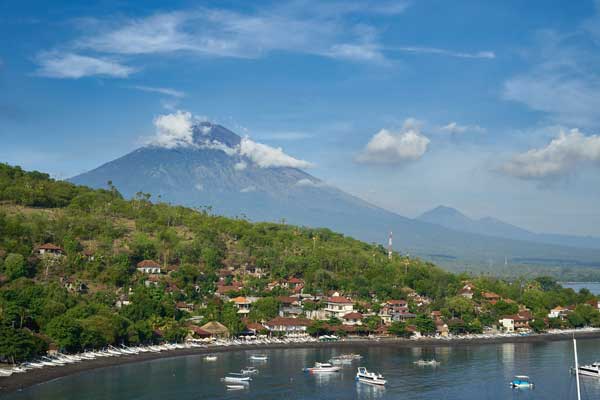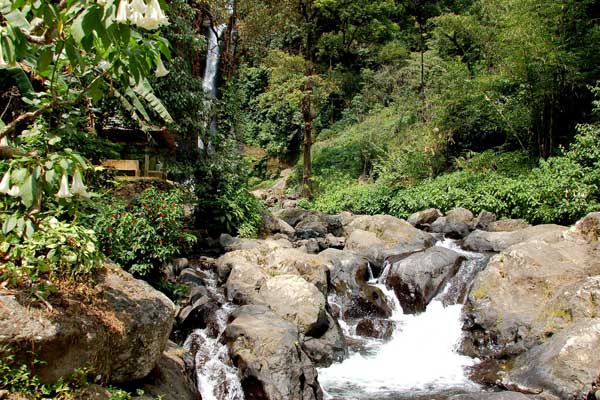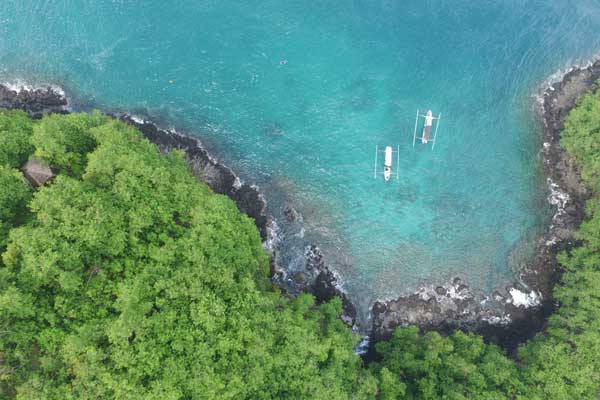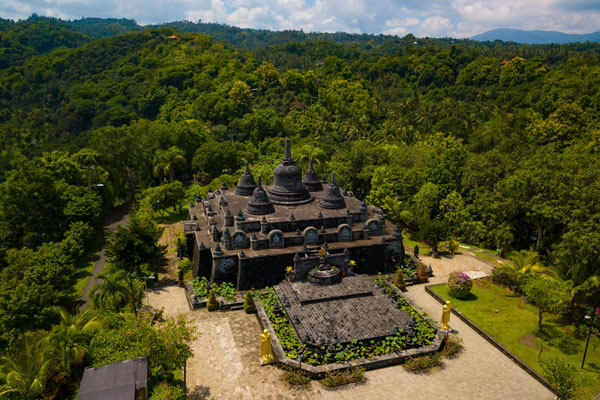Hotels, Resorts, Villas & Holiday Rentals
Must Know
Best Time to Travel
Dry & Rainy Seasons
Low, Mid & High Seasons
Bali Weather & Seasons
The climate in Bali, Indonesia is tropical, characterized by high temperatures and high humidity throughout the year. Bali is located near the equator (nearly 8 degrees south) and has two distinct seasons: the dry season, which runs from April to October and the wet or rainy season, which runs from November to March.
Weather is an important factor when it comes to planning our holidays, particularly when coming to Bali.
We have gathered on this page all you need to know about the weather and climate in Bali for your travel plans:
Best Time to Travel to Bali
When is the best time to visit Bali?
The best time to visit Bali depends mainly on 2 factors, of course the WEATHER (sunshine, rainfall, temperatures, sea conditions), and secondly, if you can travel during high and low season, which has an impact on prices for accommodation, airfares & flight tickets, and whether the destination in Bali you would choose to visit, is crowded or not.
Tip: Travel during MID-Season (Shoulder Season) – if you can
Mid-Season also known as Shoulder Season: For many reasons, the very best time to come to Bali are the months of May, June & September – while April & October are still good. Less crowded, still great weather conditions, and better prices.
Why visiting Bali during shoulder season is a smart choice?
It’s just before or after high Season, still dry season, it’s slightly less humid, and room prices and villa rentals can be 30-50% cheaper than during high season. Many shops offer sales and promotions, restaurants are less crowded in those mid-season months, and in general, Bali is a bit more relaxed. October is not too bad either, still much less rain than November (usually – check the rainfall chart).
- Room prices for these months 30-50% off high season rates
- Weather is still dry and less humid
- Not too crowded, everything is more relaxed, traffic not too crazy in the tourist areas
- Sea conditions excellent
- Airfares still reasonable
- Sales & Promotions in Shops & Restaurants
Bali Arrival Checklist
✓ Bali Tourist Tax
✓ Bali Discount Program
✓ International Driving License
✓ Bali eSIM
✓ Hotel, Villa, Resort
✓ Airport Transfer
✓ Medical Travel Insurance
✓ Custom Form
✓ Health Form
✓ Visa
When is High / Peak Season in Bali?
These are Bali’s busiest times:
- July and August
- Easter
- Christmas & New Year (Busiest)
- Chinese New Year
- End of Ramadan (Idul Fitri)
Is busy bad?
Some Bali visitors love it when it’s busy, when the streets are buzzing and the restaurants are filled with guests from all over the world and all walks of life.
If you like it quiet and more serene, then Kuta, Legian, Ubud, Seminyak, and Canggu during high season might not be your first and best choice.
Still, even during high season, there are plenty of destinations in Bali, that are quiet and away from the masses.
When is Dry and Rainy Season in Bali
Dry Season in Bali
April to October
Less Rain – Cooler Breezes
During the dry season, temperatures typically range between 80-90°F (27-32°C) and humidity is relatively low, while there is often a nice and cool breeze which is very pleasant. This is the most popular time for tourists to visit Bali, as the weather is sunny and dry with little chance of rain. Temperatures are pretty steady all year round but during dry season, the evenings can be pleasantly fresh with a cool breeze.
During Bali’s dry season, beaches are generally clean(er), and Bali shows its pretty side. One can still expect occasional rainfall. If you have a choice, then yes, better to avoid the traditionally rainy months to minimize the risk of bad weather and come to Bali during dry season.
It is in general the warmest time of the year, but the lower humidity makes it more comfortable than the rainy season. The skies are usually clear and sunny, making it ideal for outdoor activities such as swimming, sunbathing, water sports, trekking, and beach parties.
Rainy Season in Bali
November to March
More rain, hotter, much more quiet
During the rainy season, Bali experiences more rainfall and higher humidity than during the dry season. The temperatures during this time of the year are still warm, typically ranging from 75-85°F (24-29°C). The island receives most of its annual rainfall during this time, and it can be quite heavy at times, but usually, it does not rain all day, usually, there are short spells of rain that might last a couple of hours in the afternoon and during nights.
It’s still possible to enjoy many outdoor activities during this time of the year. The island’s lush tropical landscape is especially beautiful during the rainy season, with the vibrant green rice terraces and the jungle covered in mist. However, during rainy season Bali the beaches and sea in the south of Bali (Kuta, Legian, Seminyak, Canggu) can be quite dirty due to debris and trash washed onto the shore – during December, January and February particularly. That’s not a pretty sight!
Different areas in Bali - VERY Different Climate Zones
1. Coastal Areas
The coastal areas of Bali, including places like Sanur, Kuta, Seminyak, Canggu, Padangbai, and Candidasa, are typically warm and humid year-round, thanks to their proximity to the sea. These areas experience a classic tropical climate with distinct dry and wet seasons. The dry season, from April to October, is generally sunny and breezy, ideal for beach activities and water sports. Temperatures usually hover between 27°C to 32°C, with humidity levels lower than during the wet season. From November to March, the wet season brings occasional heavy rains and higher humidity. While rainstorms can be sudden and intense, they tend to pass quickly, allowing for a mix of sun and showers. Some beaches get polluted with trash washing to the shore from during January and February.
2. Central Bali, Volcanos, Highlands and the Mountains
Bali’s central mountain area and the highlands are typically cooler and get more rain than the lower coastal areas. Especially at night, temperatures can drop significantly in the highlands near the volcanoes. The regions of Ubud, Sidemen, Kintamani, Bedugul, and Batukaru are situated at an altitude of around 600-1000 meters above sea level. These areas are cooler and experience more rainfall than the coastal regions. Due to the higher elevation, temperatures are milder, generally ranging from 20°C to 27°C. Rain is more frequent throughout the year, with the wet season (November to March) being particularly lush. Even in the dry season, it’s not unusual to experience occasional showers and morning mist, especially in Bedugul and Kintamani. This cooler, more humid climate supports Bali’s rice terraces, coffee plantations, and tropical forests, making it ideal for visitors who enjoy exploring nature.
Mountains & Volcanos in Bali3. The Nusa Islands & Bukit Peninsula
and the most southern tip of Bali, BUKIT are significantly dryer and sometimes therefore hotter than Bali’s main island. The land is less fertile and the areas can struggle with fresh water supply during the dry season months. That’s why the development of golf courses did raise a lot of environmental concerns.
The Bukit Peninsula, covering areas like (Nusa Dua & Benoa, Uluwatu & Pecatu, Ungasan) as well as the Nusa Islands (Nusa Lembongan, Nusa Ceningan, Nusa Penida), have a generally drier climate compared to the rest of Bali. Here, the dry season is long, with lower humidity levels and less rainfall, even during the wet months. Temperatures are warm, typically between 28°C to 32°C, and the landscape is characterized by cliffs, scrub, and dry forests. These areas do also face water shortages during dry season, and some hoteliers and villa owners might have to get water delivered by trucks, particularly in Uluwatu.
Bali Climate Facts
Climate Chart Bali
What is the climate like in Bali? Have a look at the climate table, which should give you a good idea about temperatures during the day and the expected rainfall during dry season and rainy season. The chart represents the climate in Denpasar, Check our area map to see if your holiday area is located at the coast, or in highlands near volcanoes, or somewhere else.

Rainfall in Bali
How many days does it rain in Bali each month?
During dry season it sometimes does not rain at al, while on average on can say 3 to 6 days per month. During rainy season and depending on the area, it can go up to almost daily. See the stats below. Also check the section where we explain the different climate zones in Bali.
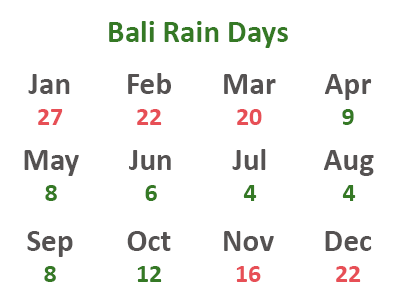

Monthly Weather Statistics for Bali
| General Weather Conditions in Bali per month | |||||||
|---|---|---|---|---|---|---|---|
| Months | max. Temp. | Rain days |
Rainfall | Season | |||
| Bali weather January | 26°C | 78°F | 27 | 34.5 cm | Rainy Season | ||
| Bali weather February | 26°C | 78°F | 22 | 27.4 cm | Rainy Season | ||
| Bali weather March | 26.5°C | 79°F | 20 | 23.4 cm | Changing Season | ||
| Bali weather April | 27°C | 80°F | 9 | 8.8 cm | Dry season | ||
| Bali weather May | 28°C | 82°F | 8 | 9.3 cm | Dry season | ||
| Bali weather June | 26.5°C | 79°F | 6 | 5.3 cm | Dry season | ||
| Bali weather July | 26.5°C | 79°F | 4 | 5.5 cm | Dry season | ||
| Bali weather August | 26.5°C | 79°F | 4 | 2.5 cm | Dry season | ||
| Bali weather September | 26.5°C | 79°F | 8 | 4.7 cm | Dry season | ||
| Bali weather October | 27°C | 80°F | 12 | 6.3 cm | Changing Season | ||
| Bali weather November | 27°C | 80°F | 17 | 17.9 cm | Rainy Season | ||
| Bali weather December | 26.5°C | 79°F | 22 | 27.6 cm | Rainy Season | ||

 Indonesia
Indonesia Deutsch
Deutsch Français
Français हिन्दी
हिन्दी










